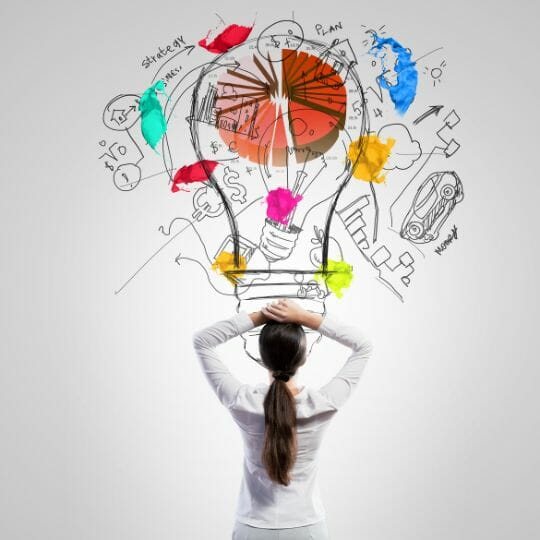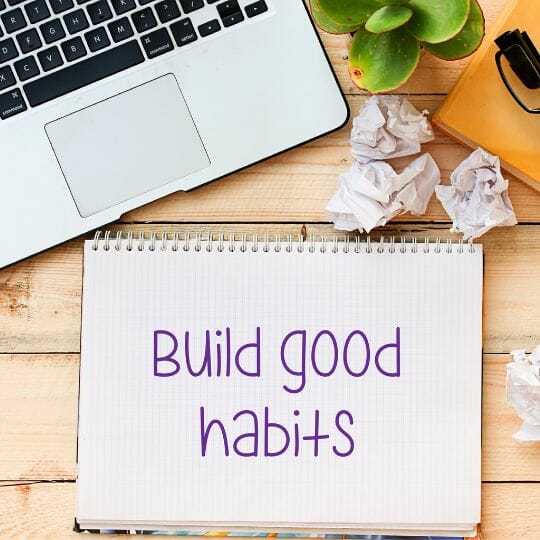
Do you have this nagging sense that there are things you should stop doing and things that you should start doing in your business? Does business feel like a grind at times, sapping your energy and creativity? If so, then it’s time to create your business plan for the next year to work out the kinks and start getting what you want with more ease and flow. That’s what I’m here to help you to do by sharing my 4-step process to developing a 2023 business plan.
It’s that time of year I start to think about the year ahead and start creating some plans for my business. I figured that you would be doing that too and that you might be wondering what sorts of goals to set.
Sharing my process will help you get clear on not just how to create a plan, but how to make an exciting plan to get you where you want to be.
A good starting point is reflecting on how this year went for you and what you’d like to do more of and less of.
When I do this process, I start by thinking about what I really loved doing this year and why I loved it, and which strengths I used. I sit with the feeling of my favourite types of work and the things that I’ve achieved and what I did to get there.
For example, this year, I loved doing the strategic thinking work behind projects and business ideas, because that taps into my strengths of creativity, innovation, problem-solving and brainstorming.
Next, I think about the things that drained my energy and dragged me down or that I found awful and difficult.
For example, this year, I found it really draining to do very detailed intricate work, logistical stuff, and anything that required a lot of very deep research-based work.
I really sat with that and thought about why I didn’t like doing that work, and it was because it created a lot of anxiety and stress. It dampened my creative thinking. Anything with too many detailed moving parts creates a sense of anxiousness that I might have forgotten something or not done something properly. I do like some types of detailed work, but not many.
Thirdly, I look at where I earned money and spent time. I spreadsheet this based on time documented in my calendar. Funnily enough, the work I love to do most takes the least time and earns me the most money. The work I dislike the most takes the most time and earns me the least money – probably because I have to do the grind to complete it.
Finally, I reflect on my most important achievement of the past year. This is important because it shows you what your toil created that you are most proud of and gets you thinking about the bigger picture. If you don’t look at the bigger picture you might end up just planning another year of doing rather than thinking about your overall direction first.
My greatest achievement this year was fulfilling four important professional roles, and even though the juggle was hard at times, it gave me a bigger picture view and understanding of two important knowledge areas (menopause and mental health), and of three bigger macro trends (psychosocial risk legislation, supporting and recognising women at work, and improving mental health at work).
With this knowledge, I have a good idea of which business ideas will succeed in 2023, where the focus and money will be in the broader economy, and what my best opportunities are. Those insights allows me to set some tangible and meaningful goals that leverage these opportunities.
When you reflect on the past year, ask yourself these questions and write some notes;

This should give you a good summary of your past year, what worked and what didn’t, in less than a page.
When you reflect on what you learned about yourself, you can potentially see the work that you need to do and the obstacles you need to face, and the skills and strengths you can leverage.
I learned a bunch of things about myself this year.
Firstly, I am persistent and can work hard to get things done.
I’ve realised that I am a sore loser – and this costs me emotionally and energetically.
I’ve noticed I prefer to fly solo so I can create my own ideas, I tend to avoid groups, but I do enjoy collaboration if it is a bit hands off and not too intimate or intense. I’ve always known this at some level but have really experienced and felt it this year.
My greatest strengths are creative brainstorming at a strategic business level and with clients, and summarizing, simplifying, and creating processes to get things done. When I do these things I am truly in flow.
Finally, I can do about 10 coaching sessions or meetings a week before I start to get overwhelmed and find it hard to focus and be present.
Having given you some examples, I now invite you to reflect on your year.
Once you’re clear on steps 1 and 2, we start to consolidate.
It’s one thing to think about what you have done and achieved and loved doing or being drained by in the last year.
The first two steps in this process allow you to evaluate the past, so you can look ahead with clarity and map out your new business habits for 2023.
In other words, it’s time to use your reflections to define what you want to keep doing, stop doing or start doing next year.
Some people like to start with their outcome goals first, and you can certainly do that. To me it makes more sense to find my flow in the process – then decide what I will create with that new way of working.

I’ve learned in my first two steps that what’s important to me is to work more strategically, to simplify things, and to scale, so I can earn comfortably and remain in flow, and be at my best with the clients I work with. This is how I will work.
Tangibly, to define the habits I’ll stop, maintain and start, my next stage of planning is to:
What would your next stage of planning look like?
Having completed the previous three steps, you’re ready to think about outcomes you will be able to realistically achieve with this new way of working.
I personally feel it’s important to keep the goals simple and few, so you can do a few things really well. As Robert Kyosaki says – the word FOCUS stands for Follow One Course Until Successful.
My outcome goals for 2023 will be achieved if I do the things previously mentioned. Here are mine.

In my business, I will be:
In the area of coach training and advocacy for our industry, I will be:
In my personal life, I will be:
This is my plan, now over to you.
What are the outcomes you want to achieve next year in your business?
What are the impacts you want to have in the world?
What will you do in your personal life to grow and evolve, show up better and function at your best?
I look forward to seeing what you create, with intention and purpose, in 2023.
If business feels like a grind at times, and you have that nagging sense that things need to change, you now have a four-step process to start getting what you want with more ease and flow. The steps to follow are:
Understanding who you are and what you need will allow your business to thrive! If you’re truly ready to break old habits and get out of the rut I encourage you to check out the Habitology membership.
Learn more here: